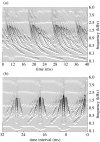Functional imaging of the auditory processing applied to speech sounds
- PMID: 17827103
- PMCID: PMC2606794
- DOI: 10.1098/rstb.2007.2157
Functional imaging of the auditory processing applied to speech sounds
Abstract
In this paper, we describe domain-general auditory processes that we believe are prerequisite to the linguistic analysis of speech. We discuss biological evidence for these processes and how they might relate to processes that are specific to human speech and language. We begin with a brief review of (i) the anatomy of the auditory system and (ii) the essential properties of speech sounds. Section 4 describes the general auditory mechanisms that we believe are applied to all communication sounds, and how functional neuroimaging is being used to map the brain networks associated with domain-general auditory processing. Section 5 discusses recent neuroimaging studies that explore where such general processes give way to those that are specific to human speech and language.
Figures




Similar articles
-
Stimulus-dependent activations and attention-related modulations in the auditory cortex: a meta-analysis of fMRI studies.Hear Res. 2014 Jan;307:29-41. doi: 10.1016/j.heares.2013.08.001. Epub 2013 Aug 11. Hear Res. 2014. PMID: 23938208 Review.
-
Locating the initial stages of speech-sound processing in human temporal cortex.Neuroimage. 2006 Jul 1;31(3):1284-96. doi: 10.1016/j.neuroimage.2006.01.004. Epub 2006 Feb 28. Neuroimage. 2006. PMID: 16504540
-
[Auditory perception and language: functional imaging of speech sensitive auditory cortex].Rev Neurol (Paris). 2001 Sep;157(8-9 Pt 1):837-46. Rev Neurol (Paris). 2001. PMID: 11677406 Review. French.
-
Maps and streams in the auditory cortex: nonhuman primates illuminate human speech processing.Nat Neurosci. 2009 Jun;12(6):718-24. doi: 10.1038/nn.2331. Epub 2009 May 26. Nat Neurosci. 2009. PMID: 19471271 Free PMC article. Review.
-
Decoding four different sound-categories in the auditory cortex using functional near-infrared spectroscopy.Hear Res. 2016 Mar;333:157-166. doi: 10.1016/j.heares.2016.01.009. Epub 2016 Jan 29. Hear Res. 2016. PMID: 26828741
Cited by
-
Neuroimaging with near-infrared spectroscopy demonstrates speech-evoked activity in the auditory cortex of deaf children following cochlear implantation.Hear Res. 2010 Dec 1;270(1-2):39-47. doi: 10.1016/j.heares.2010.09.010. Epub 2010 Oct 1. Hear Res. 2010. PMID: 20888894 Free PMC article.
-
Atypical Bilateral Brain Synchronization in the Early Stage of Human Voice Auditory Processing in Young Children with Autism.PLoS One. 2016 Apr 13;11(4):e0153077. doi: 10.1371/journal.pone.0153077. eCollection 2016. PLoS One. 2016. PMID: 27074011 Free PMC article.
-
The processing of audio-visual speech: empirical and neural bases.Philos Trans R Soc Lond B Biol Sci. 2008 Mar 12;363(1493):1001-10. doi: 10.1098/rstb.2007.2155. Philos Trans R Soc Lond B Biol Sci. 2008. PMID: 17827105 Free PMC article. Review.
-
Phonological repetition-suppression in bilateral superior temporal sulci.Neuroimage. 2010 Jan 1;49(1):1018-23. doi: 10.1016/j.neuroimage.2009.07.063. Epub 2009 Aug 3. Neuroimage. 2010. PMID: 19651222 Free PMC article.
-
Dynamic changes in superior temporal sulcus connectivity during perception of noisy audiovisual speech.J Neurosci. 2011 Feb 2;31(5):1704-14. doi: 10.1523/JNEUROSCI.4853-10.2011. J Neurosci. 2011. PMID: 21289179 Free PMC article.
References
-
- Amunts K, Schleicher A, Burgel U, Mohlberg H, Uylings H, Zilles K. Broca's region revisited: cytoarchitecture and intersubject variability. J. Comp. Neurol. 1999;412:319–341. doi:10.1002/(SICI)1096-9861(19990920)412:2<319::AID-CNE10>3.0.CO;2-7 - DOI - PubMed
-
- Belin P, Zatorre R.J, Lafaille P, Ahad P, Pike B. Voice-selective areas in human auditory cortex. Nature. 2000;403:309–312. doi:10.1038/35002078 - DOI - PubMed
-
- Belin P, Zatorre R.J, Ahad P. Human temporal-lobe response to vocal sounds. Brain Res. Cogn. Brain Res. 2002;13:17–26. doi:10.1016/S0926-6410(01)00084-2 - DOI - PubMed
-
- Belin P, Fecteau S, Bedard C. Thinking the voice: neural correlates of voice perception. Trends Cogn. Sci. 2004;8:129–135. doi:10.1016/j.tics.2004.01.008 - DOI - PubMed
-
- Bendor D, Wang X. The neuronal representation of pitch in primate auditory cortex. Nature. 2005;436:1161–1165. doi:10.1038/nature03867 - DOI - PMC - PubMed
Publication types
MeSH terms
Grants and funding
LinkOut - more resources
Full Text Sources

